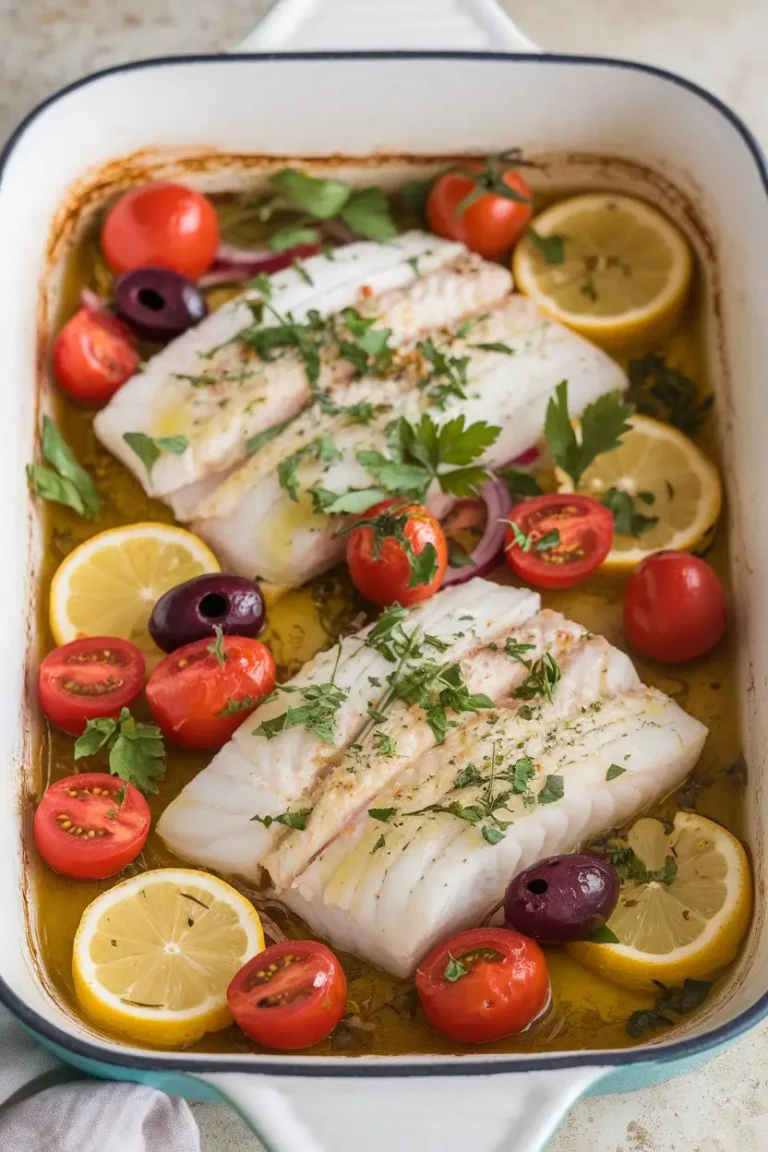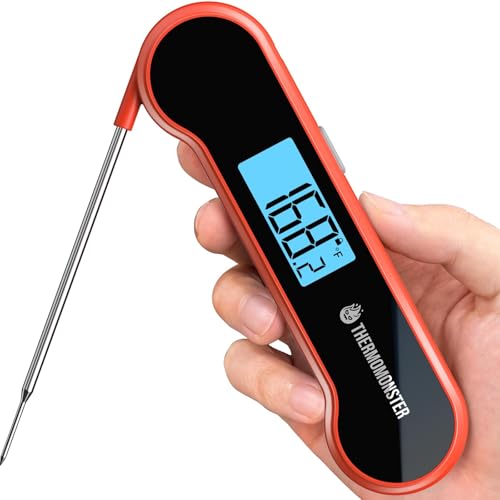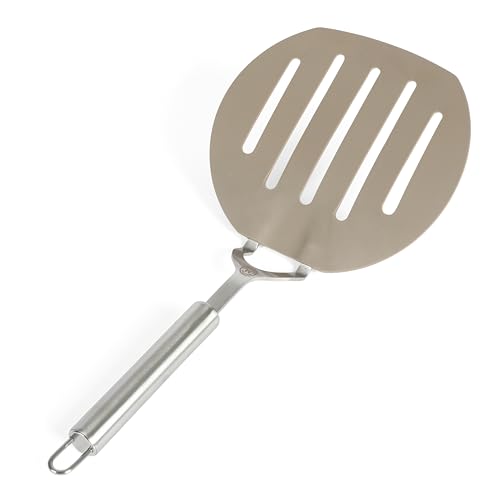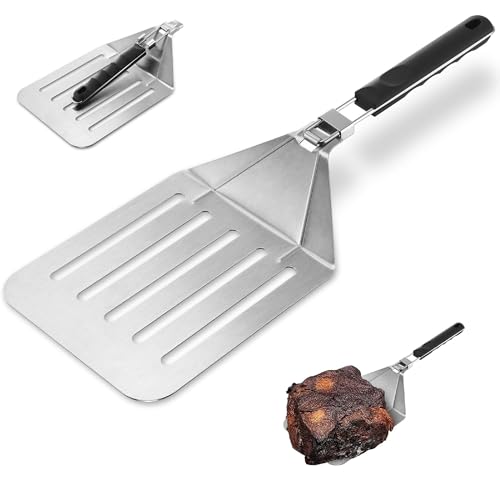There is a certain brightness that Mediterranean cooking brings to the table: clean flavors, generous use of olive oil, juicy tomatoes, briny olives, herbs that smell like summer, and citrus that keeps every bite lively. Bake a piece of Mediterranean baked fish in that company and you get a dish that is simple to execute and deeply satisfying. It feels light, yet it never leaves you hungry. It is weeknight-friendly and it also works when guests are at the door.
This approach rewards good ingredients and uncomplicated technique. The oven does most of the work, and you get tender fish with a flavorful pan sauce that begs for a piece of bread or a spoon of couscous.
Why this style of cooking supports heart wellness
Mediterranean cooking patterns have been linked to better cardiovascular markers, and a tray of baked fish with tomatoes and olive oil fits squarely into that idea.
- Fat profile: Fish brings omega-3 fats, and extra-virgin olive oil brings mostly monounsaturated fats. That combination is linked to favorable lipid profiles.
- Produce-forward: Tomatoes, peppers, onions, and herbs offer potassium, polyphenols, and fiber. You add flavor without relying on heavy sauces.
- Salt smart: Briny ingredients like capers and olives deliver punch, which often allows less added salt.
- Gentle method: Baking keeps the oil amount modest and avoids scorching.
Small details matter. Using a flavorful extra-virgin olive oil means you can use less of it. Fresh herbs make the dish taste vivid even with minimal salt.
Choosing the right fish
You can make this with many varieties. Two paths work especially well:
- Mild white fish that cooks quickly and stays flaky: cod, haddock, halibut, pollock, grouper, snapper.
- Oily fish with richer flavor and more omega-3s: salmon, trout, mackerel, sardines.
Thickness is the key variable. A 1-inch thick piece behaves differently from a thin fillet. Uniform thickness helps prevent overcooking.
Sourcing matters too. Ask for fish that smells like the sea, not fishy. Frozen fillets from a trusted brand can be excellent because they are often frozen soon after harvest.
Quick comparison guide
| Fish type | Flavor | Texture | Relative mercury | Typical fillet thickness | Approx cook time at 425 F | Sourcing notes |
|---|---|---|---|---|---|---|
| Cod | Mild, sweet | Flaky | Low | 1 to 1.5 in | 10 to 14 min | Widely available, look for MSC-certified options |
| Haddock | Mild | Delicate | Low | 0.75 to 1 in | 8 to 12 min | Similar to cod, good freezer candidate |
| Halibut | Clean, slightly meaty | Firm | Moderate | 1 to 1.5 in | 12 to 15 min | Choose Pacific sources where possible |
| Salmon | Rich | Buttery, flakes in large pieces | Low to moderate | 1 to 1.25 in | 10 to 13 min | Wild Alaskan or responsibly farmed |
| Trout | Mild to medium | Tender | Low | 0.75 to 1 in | 8 to 11 min | Fresh or steelhead both work |
| Mackerel | Robust | Oily, moist | Low | 0.5 to 1 in | 7 to 10 min | Great omega-3 content, best very fresh |
| Snapper | Mild | Firm | Low | 0.75 to 1 in | 9 to 12 min | Often sold whole or as fillets |
Times are estimates for fillets at refrigerator temperature. If your fish is still quite cold, add 1 to 2 minutes. If it is room temperature, subtract 1 to 2 minutes. Pull when the center flakes with gentle pressure and looks just opaque.
- MAX CRISP TECHNOLOGY: Delivers up to 450°F of superheated air for faster, hotter, and extra-crispy results using little …
- Guilt-Free, Healthy Fried Foods: Enjoy the indulgence of fried food with up to 75% less fat compared to traditional deep…
- XL Capacity Air Fryer: The 6.5-quart nonstick basket and crisper plate hold up to 5 lbs. of French fries or 9 lbs. of ch…
Pantry and produce checklist for 4 servings
The base recipe below serves four generously. Scale it based on your crowd.
- 1.5 to 2 pounds fish fillets, skin removed unless using salmon or trout
- 1 large lemon, zested and juiced
- 1 pint cherry or grape tomatoes, halved
- 1 small red onion, thinly sliced
- 1 red bell pepper, cut into strips
- 3 garlic cloves, minced
- 1.5 cups pitted olives, mixed green and black if available
- 2 tablespoons capers, rinsed
- 1 teaspoon dried oregano or 1 tablespoon fresh oregano leaves
- 1 tablespoon chopped fresh thyme or rosemary, or a mix
- 1 teaspoon sweet paprika
- 1 pinch red pepper flakes
- 5 tablespoons extra-virgin olive oil
- 1 teaspoon kosher salt, plus more to taste
- 1 teaspoon freshly ground black pepper
- 0.25 cup chopped flat-leaf parsley or basil, for serving
Optional but recommended:
- 0.5 cup dry white wine or low-sodium vegetable broth
- 1 tablespoon sherry vinegar or red wine vinegar
- 0.25 cup crumbled feta
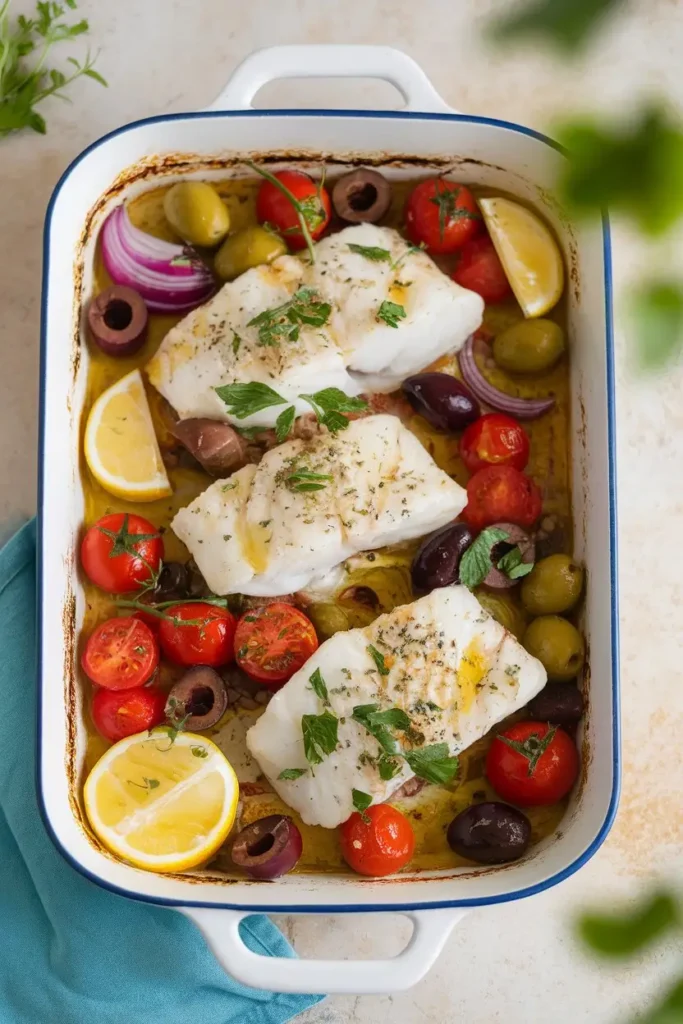
Step-by-step: from prep to plate
Set the oven to 425 F. A hot oven keeps vegetables lively and helps fish cook evenly.
- Season the fish
- Pat the fillets dry with paper towels.
- Season both sides with 0.5 teaspoon salt and 0.5 teaspoon black pepper.
- Zest the lemon directly over the fish and rub it in. Set aside while you prep the vegetables.
- Build the vegetable bed
- In a large bowl, toss tomatoes, onion, pepper, garlic, olives, and capers with 4 tablespoons olive oil, oregano, thyme, paprika, red pepper flakes, and 0.5 teaspoon salt.
- Add the lemon juice, plus white wine or broth if using. Vinegar goes in now if not using wine.
- Spread this mixture in a wide baking dish or on a rimmed sheet pan. You want the vegetables mostly in a single layer.
- Par-roast the vegetables
- Roast the vegetable mixture for 10 minutes. This step starts the softening, so the fish can cook in a juicy, flavorful base without overcooking.
- Nestle the fish
- Remove the pan, toss the vegetables, and create four spaces.
- Drizzle the last tablespoon of olive oil over the fish and set the fillets into the spaces.
- Spoon some of the vegetables on top of each fillet without burying them.
- Bake to doneness
- Return to the oven and bake 8 to 12 minutes. Thin fillets finish on the low end. Thicker or fattier pieces take a bit longer.
- Check at the earliest time point. The fish should flake gently and look opaque with a hint of gloss in the center.
- Food safety guidance sets 145 F at the thickest part. Many cooks pull at 130 to 135 F for a juicier result, then rest for 2 minutes. Choose based on your preference.
- Finish and serve
- Squeeze another splash of lemon. Scatter parsley or basil. Add feta if you like a salty finish.
- Taste the juices in the pan. Adjust with a pinch of salt, extra olive oil, or a dash more vinegar.
It is that straightforward. The vegetables release liquid that mingles with olive oil, wine, and lemon to form a light sauce. Bread or grains help capture every drop.
Flavor variations that keep it fresh
A repeatable recipe is handy. A flexible one is better. Here are a few twists to rotate through your calendar.
- Lemon-caper and dill
- Swap oregano and thyme for 0.25 cup chopped dill.
- Double the capers. Use more lemon zest and less juice for intense citrus aroma.
- Fennel-orange
- Replace bell pepper with sliced fennel bulb.
- Add strips of orange zest and 0.5 cup orange segments in the last 5 minutes.
- Harissa-tomato
- Stir 1 to 2 teaspoons harissa paste into the vegetable mix.
- Add a touch of honey to balance the heat, and finish with mint.
- Almond-herb crust
- Pulse 0.5 cup raw almonds with parsley, oregano, lemon zest, and a spoon of olive oil.
- Press lightly onto seasoned fillets before adding to the pan for a nutty crust.
- Saffron and artichoke
- Steep a pinch of saffron in the warm broth or wine and use marinated artichoke quarters with the tomatoes.
Each variation keeps the core method intact while changing the aroma and accent. The mediterranean baked fish remains the star.
Seasoning science in plain language
Salt pulls moisture to the surface. When you season the fish early, it gives that moisture time to reabsorb, taking seasoning with it. That means more flavor without excess salt. Acid from lemon and vinegar tightens the protein structure a bit, which reads as flake rather than mush.
Olive oil choice matters. Extra-virgin oils vary. A peppery one adds pleasant bite to a richer fish like salmon. A softer, buttery oil flatters delicate cod. You do not need a lot. A good oil will be tasted even in small amounts.
Tomatoes release water as they bake. Par-roasting drives off some moisture and concentrates flavor so the fish does not poach too aggressively. Tossing the vegetables halfway keeps edges from drying while still giving some caramelization.

Make-ahead and leftovers
- Meal prep: Slice the onion and pepper, halve tomatoes, and pit olives up to 24 hours in advance. Toss with oil, herbs, and refrigerate.
- Do not marinate delicate white fish in lemon for long. Acid can change the texture. Season with salt and zest ahead of time, then add lemon juice just before baking.
- Leftovers keep for 2 days in the fridge. Reheat gently in a low oven at 275 F for about 8 minutes or flake cold into a salad.
- Cold leftovers are very good with baby arugula, cucumber, a spoon of the pan juices, and an extra squeeze of lemon.
Serving ideas that make the plate complete
This dish gives you a lot of flexibility. Let the sides fit your schedule.
- Fast and satisfying
- Whole wheat couscous
- Crusty bread to swipe through the pan juices
- Quick sautéed greens with garlic
- Cozy and hearty
- Lemon potatoes roasted in the same oven
- Farro cooked with a bay leaf and a drizzle of olive oil
- Charred broccolini with chili flakes
- Bright and fresh
- Tabbouleh loaded with herbs
- Cucumber and tomato salad
- Orange wedges with a sprinkle of sea salt
Pairings: a crisp white like Albariño or Vermentino, or chilled rosé. Non-alcoholic options include sparkling water with lemon and a sprig of mint.
Common pitfalls and quick fixes
- Dry fish
- Cause: Overcooking or very thin fillets in a hot oven.
- Fix: Check early. Use a thermometer. Pull at 130 to 135 F and rest.
- Watery pan
- Cause: Crowded vegetables or not par-roasting.
- Fix: Use a wide pan. Pre-roast the vegetables. Let the dish sit 2 minutes after baking to settle.
- Blandness
- Cause: Light hand with salt and acid.
- Fix: Taste the sauce while hot. Add a pinch of salt and a splash of lemon or vinegar. A small hit of olive oil carries aroma.
- Uneven cooking
- Cause: Mixed thickness fillets.
- Fix: Fold thinner tail ends under to even thickness or start thicker pieces a minute earlier.
- Fish sticks to the pan
- Cause: Not enough oil on the fish or very dry baking dish.
- Fix: Lightly oil the fish and the vegetable bed. Use parchment for insurance.
- Not a fan of olives
- Swap with chopped roasted red peppers and extra capers. You still get depth without the briny olive bite.
A 30-minute weeknight schedule
- Minute 0 to 5: Heat the oven to 425 F. Prep garlic, onion, pepper, and tomatoes. Pat fish dry, season, and zest lemon.
- Minute 5 to 10: Toss vegetables with oil, herbs, lemon juice, and briny bits. Spread on pan. Start par-roast.
- Minute 10 to 15: Clear spaces, add mediterranean baked fish, drizzle olive oil.
- Minute 15 to 25: Bake until the fish flakes. Chop herbs.
- Minute 25 to 30: Finish with lemon and herbs. Plate with a fast side.
Set the table while the fish finishes. Dinner lands hot and on time.
Nutrition snapshot per serving
These numbers are estimates for 6 ounces of cod with the vegetable base and 2 teaspoons olive oil per person. Different fish and the amount of olive oil used will change the values.
- Calories: 380 to 450
- Protein: 35 to 42 grams
- Fat: 18 to 24 grams
- Saturated fat: 3 to 5 grams
- Carbohydrates: 12 to 18 grams
- Fiber: 3 to 5 grams
- Omega-3s: 500 to 1200 mg depending on fish
- Sodium: varies with olives, capers, and salt used
To keep sodium in check, rinse capers, choose no-salt-added tomatoes if using canned in winter, and season in stages while tasting.
Shopping tips and sustainability notes
- Look for clear, bright eyes and firm flesh if buying whole fish. Fillets should look moist and keep a tight shape.
- Frozen can be a smart choice. Thaw gently in the fridge, still in its package, overnight. Pat dry after opening.
- Ask for skin-on salmon. The skin protects the flesh and can be lifted off easily after cooking.
- Certifications like MSC and ASC can help, though local knowledge from a good fishmonger is just as valuable. Regional guides can point you toward well-managed fisheries.
Equipment that simplifies the process
- A heavy, light-colored metal sheet pan for fast heat and easy cleanup
- Parchment paper to reduce sticking
- An instant-read thermometer for accurate doneness
- A microplane for quick lemon zest
- A wide spatula that supports delicate fillets
You do not need specialty cookware. Good heat and decent tools do most of the work.
Frequently asked questions
- Can I use frozen fish without thawing?
- Thawing gives better texture. If you must cook from frozen, roast vegetables longer, then add the fish and extend cooking by a few minutes. Season the frozen fish on the surface only.
- Skin on or off?
- Skin-on works well for salmon and trout. Bake skin side down and lift the flesh off after cooking. For cod or halibut, skin is often removed before sale.
- Parchment or foil?
- Parchment keeps acidity from reacting with metal and helps prevent sticking. Foil is fine, though it can steam more. For crisp edges on vegetables, skip both and use a lightly oiled pan.
- What tomatoes work outside peak season?
- Cherry or grape tomatoes are consistent year-round. In winter, canned whole tomatoes drained and torn into chunks are a solid backup.
- Can I cook it in a skillet on the stove?
- Yes. Sauté the vegetables until tender, push to the sides, sear the fish briefly, then finish covered on low with a splash of wine. The oven is more hands-off, but the skillet route is fast.
- Air fryer?
- Works with thin fillets and a smaller batch of vegetables. Pre-cook the vegetables for a few minutes, then add the fish. Watch closely to avoid overcooking.
Scaling for a crowd
Cooking for six to eight is simple with two pans. Split the vegetables evenly and rotate the pans halfway for even heat. Stagger the fish by thickness. The first pan can rest while the second finishes, and both will be ready for the table at the same time.
For large-format presentation, consider a whole fish like snapper or branzino. Stuff the cavity with herbs, lemon, and garlic, scatter the same vegetable mix around, and roast until the backbone lifts easily. Use the same flavor base and timing cues, then set the platter in the center of the table so everyone can help themselves.

